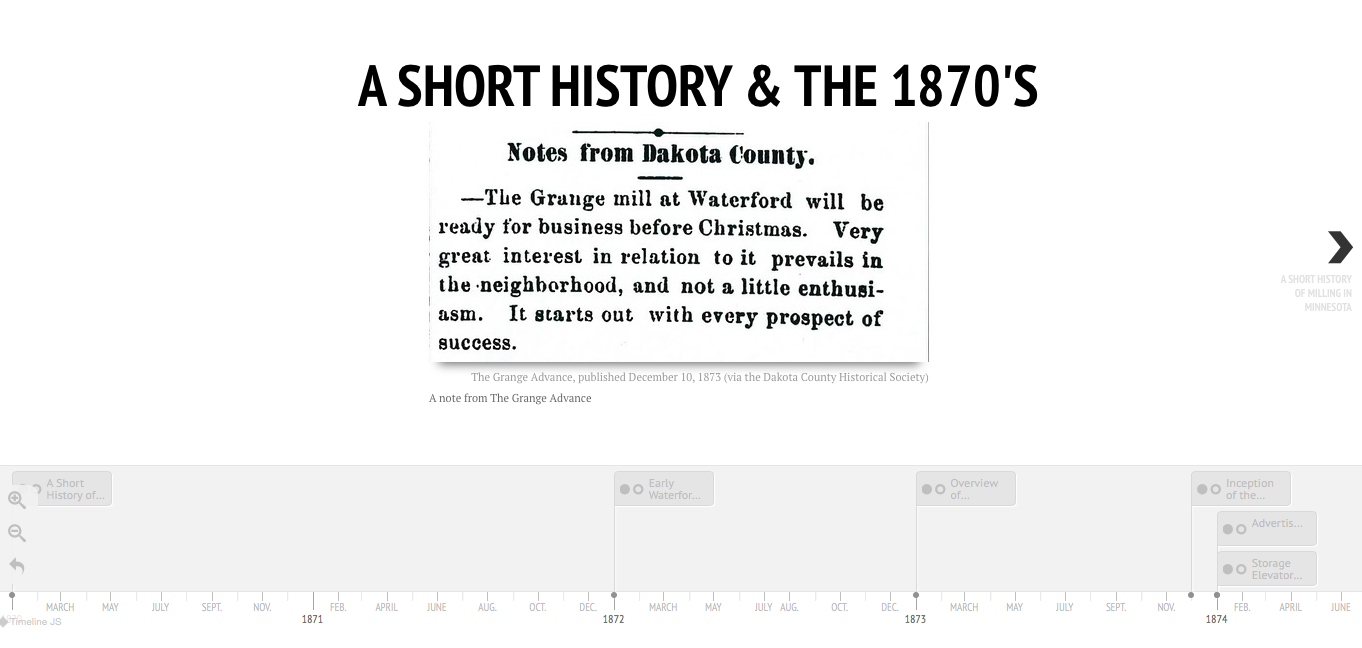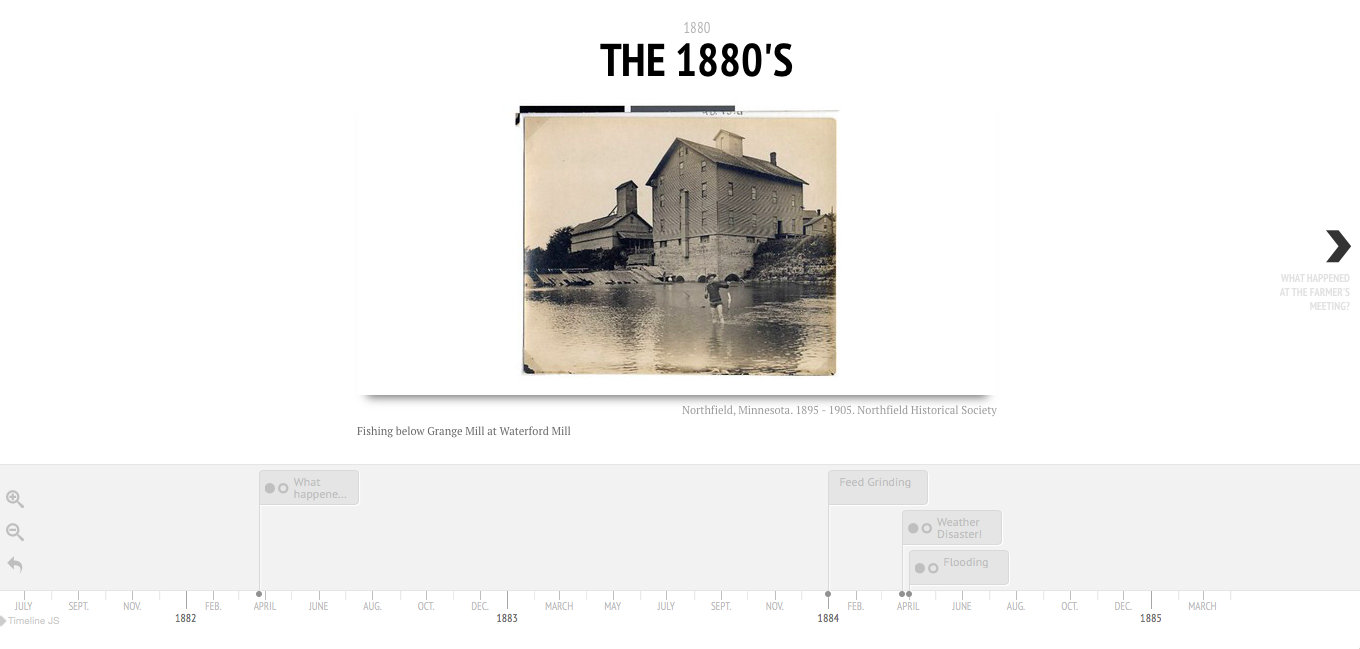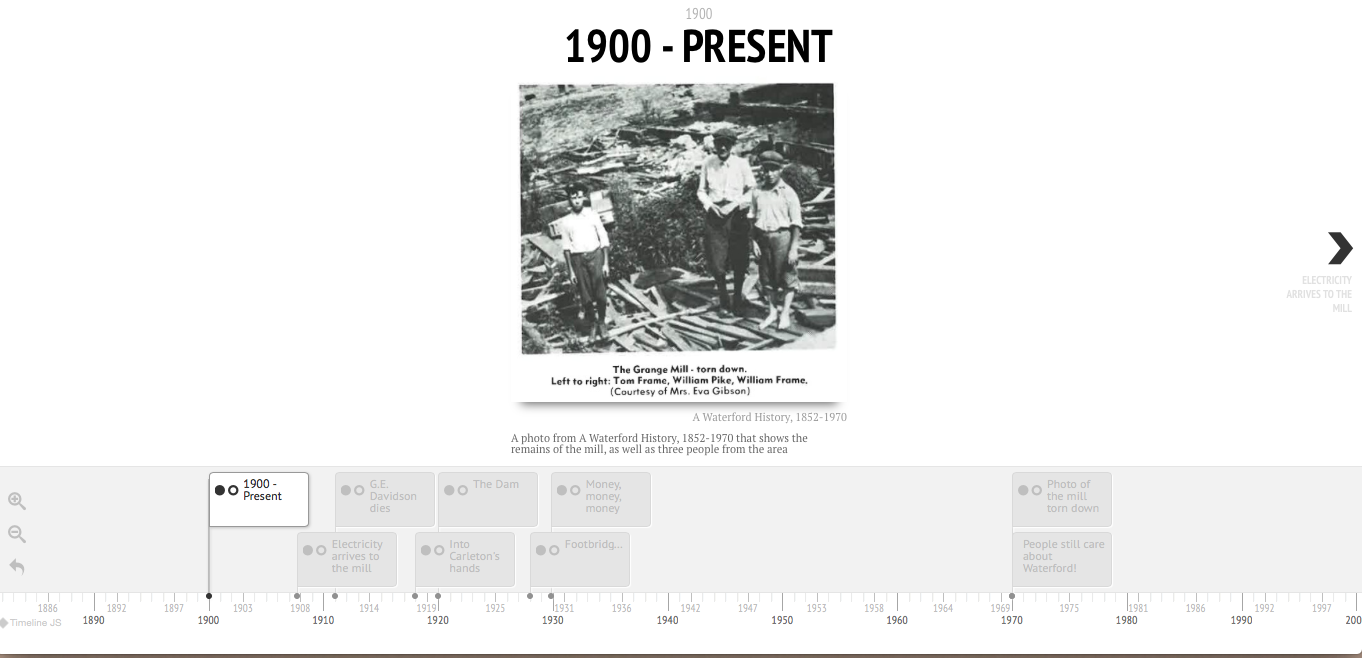By Anya Gould, Jaylin Lowe, and Matthew Rosenberg
Introduction
In order to better understand our discoveries at the Waterford Mill site in context, we chose to investigate any documents connected to the Waterford Mill, the township and village of Waterford, and more broadly, the history milling in southern Minnesota. We hoped to find documentary records of the construction of the mill, milling developments or innovations, renovations or changes in ownership, and any other important events that may have occurred at the Waterford Mill. In general, we hoped to gain a greater understanding of the site not only as a discrete entity, but also as it fits into the history of milling in the Cannon River Valley as a whole, and also hoped to contribute to the work of other groups’ final projects.
Methods and Research Process
We contacted various historical societies and archives throughout Dakota and Rice counties in the hopes of finding historical documents about the Waterford Mill. We contacted the Carleton Archives, the St. Olaf Archives, the Northfield Historical Society, the Dakota County Historical Society, and the Minnesota Historical Society in our search for records. Only the Dakota County Historical Society and the Minnesota Historical Society had information specifically about Waterford and the Waterford Mill. We also did research through the digitized Northfield News Archives, in addition to researching general milling trends and the history of Waterford on the Internet. Most of our documents come from the Northfield News Archives or the Dakota County Historical Society.
We searched the Northfield News Archives simply by entering keywords such as “Waterford Mill.” Though this gave us a huge number of search results, many of them were duplicates of the same article or advertisement that had been published in the newspaper multiple times. We went through all of the search results from these keywords, but mainly just found advertisements accompanied by a few different articles about different lessees of the mill. We also found articles about various other events that occurred near the mill, such as the deaths of children on the Cannon. The Northfield News Archives would be a very useful resource for anyone interested in general Waterford events or history; as for our specific scope of inquiry, it gave us some material, but not as much as we would have liked.
We also tried entering terms such as “Waterford Mill” or names in Google, such as G.E. Davidson and R.H. Morrow, once we knew that they had been lessees of the mill. This was not fruitful at all, and we mostly found information about Waterford, Michigan, or people with the last name of Mills. Dedicated archives are definitely the way to go to find out information about Waterford or the mill site.
At the Minnesota Historical Society’s extensive research library, the documents pertaining to Waterford were mostly county-based surveys and histories that, rather than specifically focusing on Waterford, included information about the township as part of a larger survey of Dakota County. In addition to histories of Dakota County, the Minnesota Historical Society’s library contained such sources as original county auditors’ logbooks from as far back as the 1890s. Though these were fascinating, it was difficult to connect them back to what we’d already found, since the only information in such business-focused historical documents that might relate to the Waterford Mill would be the names of those who worked there. The library and archives themselves were very well maintained; rather than loose boxes on shelves, the archives had a system wherein researchers submit a request for certain materials, which, once processed, a librarian would bring to the researcher’s table. It was a very streamlined process, and one that made the vast collection of the Minnesota Historical Society more navigable.
The Dakota County Historical Society, though a much smaller operation, was a very fruitful resource when it came to examining specifically mill-related documents. The organization’s head of research and archives gave us folders dedicated to Waterford history and Waterford business. Each folder contained documents ranging from snippets of local newspapers mentioning the mill’s first operations to reflections on the history of Waterford written in the 1970s, well past the mill’s fall into disrepair. Beyond the relevance of the documents themselves, our research process was greatly aided by having an archivist curate a set of documents specifically for our project. Though the Dakota County Historical Society wasn’t on the same scale as the Minnesota Historical Society’s two research libraries, its archives actually contained more relevant material, since sources such as small newspaper clippings that might not be easily found (even in digitized collections) were included in what their archivist gave us.
The Timelines
The timelines below showcase a collection of documents and events and descriptions of their importance or impact on the Waterford Mill and the area in general. There are four timelines, with the first three focusing on specific decades, and the last one containing everything post-1900, as the record grows thin quickly. Click on each image to be taken to the timeline for that decade or time period, and close the tab to return to this page and explore the others!
The 1870s
In the 1870s, documents about the mill focus on the milling process and the flour grinding that the mill was intended for. From the documents we found, it appears that the mill did fairly robust business in the 1870s. The Cannon River Company had enough money to add a storage elevator to the Waterford Mill and even to buy the nearby Granville Mill.

The 1880s
It appears as if business continued as normal in the 1880s, though with a few notable challenges. The mill faced rough weather and significant flooding in 1884, although it appears that the community cared enough about the mill that they were willing to work to try to protect it from some of the weather damage. This collective effort could be born of nothing more than Waterford’s close-knit community dynamic, but it also suggests that the mill was bringing in business to the town and positively impacting the community. If the mill brought people and their business to Waterford, this may have prompted the response to save the mill from some of the weather issues. Other than records of the weather issues and a few other documents, the 1880s do not present many remarkable records. For the most part, it looks like the mill continued to do well with no major changes to its situation.

The 1890s
The 1890s appear to have been when the mill started having problems. The Cannon River Company started leasing out the mill to various people throughout the decade, and even had to hire a receiver (an alternative to bankruptcy) in 1896. Almost all of the documents we found from the 1890s are about different people leasing the mill. The shortest lease time appears to be one year, so if this was the typical lease duration, there are many lessees that we don’t know about. We were only found the lesses included in the timeline because they ran advertisements or announcements in the Northfield News. We couldn’t find records of deeds or contracts relating to these transactions, despite searching the archives. Therefore, it is likely that there were other leases in place in the years beyond those of the extant contracts. The mill was likely going through a chaotic time during the 1890s, due to these frequent changes of control.

Post-1900
After 1900, the uses of the mill shifted away from a focus on flour grinding towards more varied uses. The milling industry was slowing down at this point, partly due to soil exhaustion in the area and the introduction of regular freight trains coming in and out of the Twin Cities, which could carry grain directly to mills in in Minneapolis and St. Paul. As a result, the mill began to be used for electricity instead. Most of the documents we found from this time period are photos or informational documents from earlier times, but they illustrate how there was still interest in Waterford and its mill, even long after the mill’s fall from its industrial heyday. The mill site also passed into Carleton’s hands in this period, at which point documents shift to describing footbridges near the site and delineating monetary concerns of purchasing the site.

List of Resources
“A ‘Special’ Letter Exposed,” 1882. St.Paul Globe. Dakota County Historical Society.
“All Roads Lead to Waterford,” 1890. Northfield News. Northfield News Archives.
“Flood on the Cannon River,” 1882. St. Paul Globe. Dakota County Historical Society.
History of Waterford, 1970. Dakota County Historical Society.
“Mill Statistics,” 1877. Dakota County Historical Society.
“The Geology of Minnesota: Final Report,” 1888. Minnesota Geological and Natural Survey.
Additional Untitled General Sources:
Letter to the Editor, 1879. St. Paul Globe. Dakota County Historical Society.
Various advertisements and untitled articles from the Northfield News, various dates. Northfield News Archives.
Various articles from Farmington Press, 1957. Dakota Historical Society.
Unpublished material from the Carleton Archives, 1929.